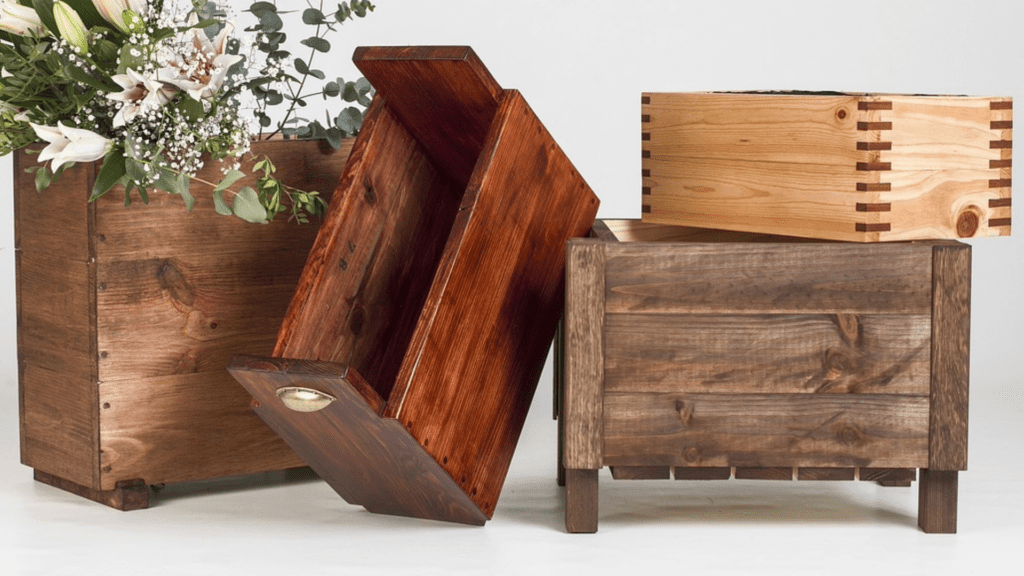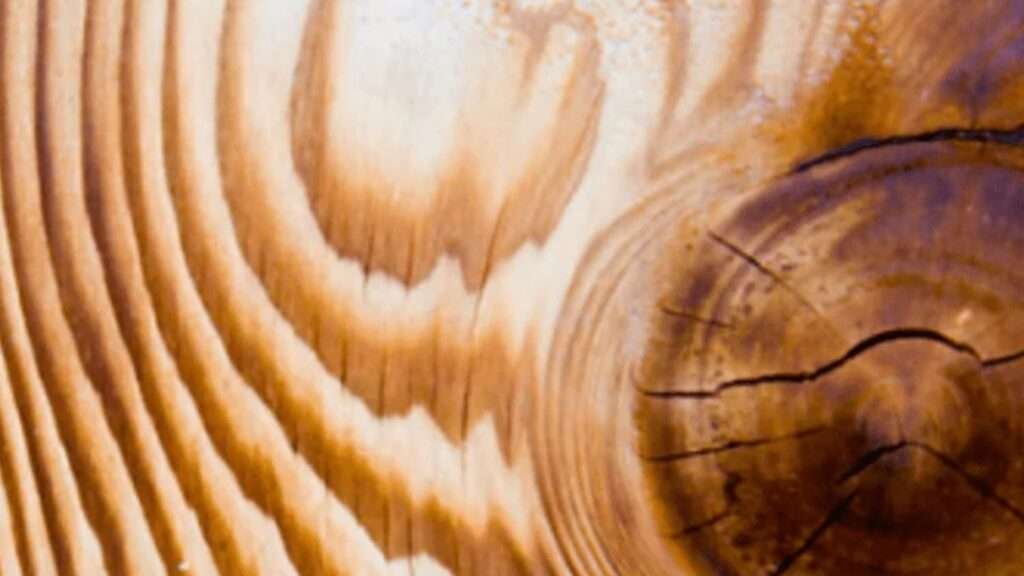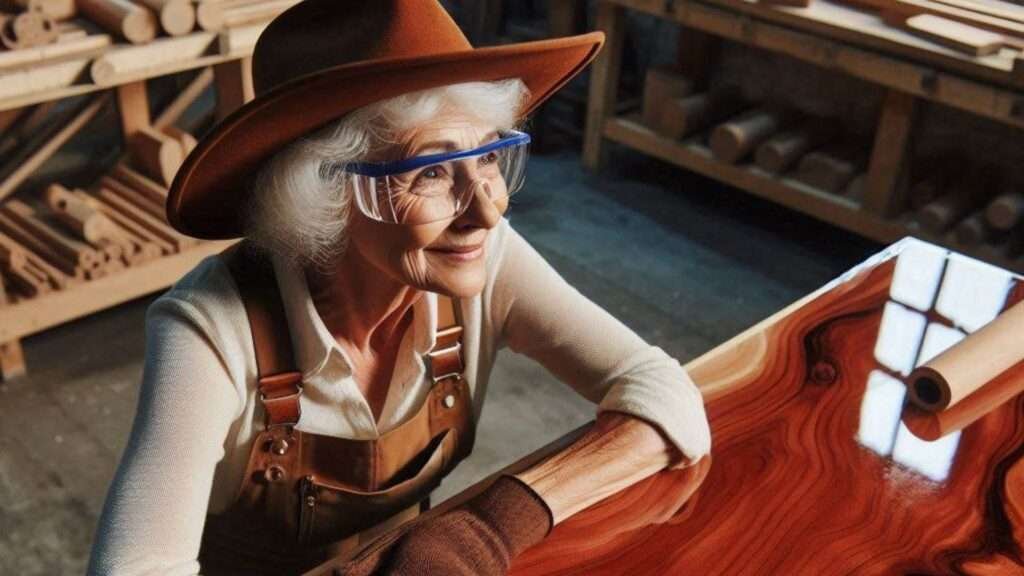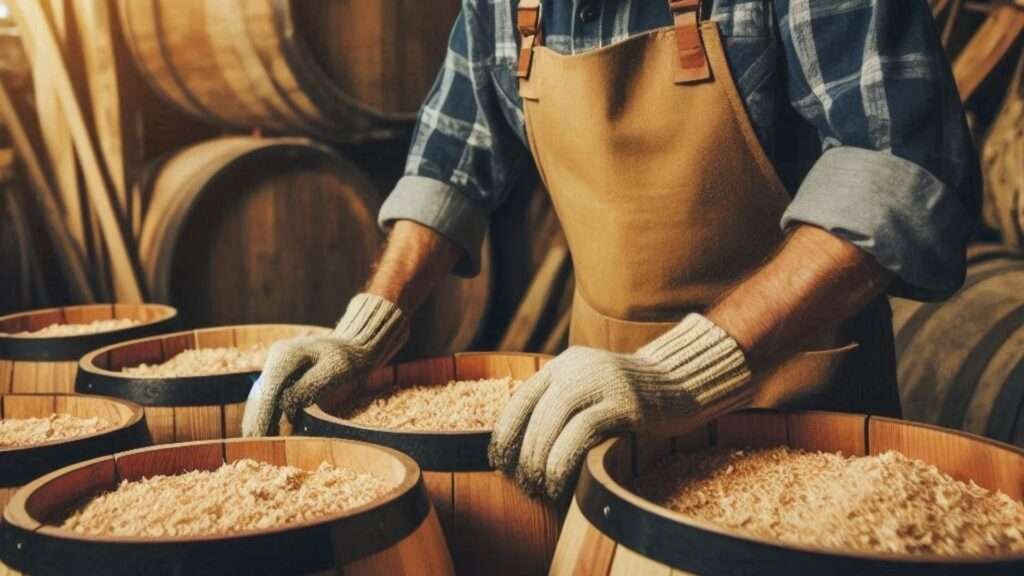Western Cedar Projects For Your Backyard.
Our backyards are many things to us and we frequently use them as sanctuary, a place where we can relax, entertain, and reconnect with nature.
As woodworkers, we have a unique opportunity to transform these outdoor spaces into multifunctional and visually appealing environments by leveraging our skills and experience.
In this article, I’d be looking at some Western Cedar projects that can enhance both the functionality and aesthetics of our backyards.
Western red cedar is highly recommended for these projects, thanks to its exceptional properties.
Cedar wood, known for its natural resistance to decay and insect damage, is a durable and long-lasting material ideal for outdoor structures.
Furthermore, its natural beauty is breathtaking; its colour and distinct grain patterns add an air of elegance and sophistication to any backyard project.
Cedar wood’s versatility allows for a wide range of creative and practical applications, including pergolas, garden benches, raised garden beds, and birdhouses.
These structures not only serve functional purposes but also contribute significantly to the overall landscape design.
By incorporating well-crafted cedar wood projects, you can create a cohesive and inviting outdoor living space that meets your specific needs and preferences.
However, to fully capitalize on the benefits of cedar wood, proper finishing and maintenance are essential.
Applying a suitable finish will protect the wood from weathering and UV damage, preserving its natural beauty over time.
Regular upkeep, such as cleaning and reapplying finishes, is crucial to maintain the wood’s integrity and appearance.
By following these practices, you can ensure that your cedar wood projects remain in excellent condition for years to come.
As you’ll discover over the remainder of this article, I’ve come up with 16 cedar wood projects that should improve the overall appeal of a backyard.
Whether you’re a seasoned woodworker or just getting started, these projects will provide a good starting point for transforming your outdoor space into a haven of functionality and beauty.
Why Choose Western Red Cedar?
Western red cedar is a top choice for outdoor woodworking projects due to its natural properties and aesthetic appeal.
One of the primary benefits of western red cedar is its inherent resistance to decay and insect damage.
This resistance is due to the presence of natural compounds called thujaplicins, which act as preservatives and make the wood durable and long-lasting in various weather conditions.
Another notable advantage of western red cedar is its visual appeal. The wood’s rich, warm hues range from light amber to deep brown, and its fine, straight grain adds a touch of elegance and character to any backyard setting.
Over time, western red cedar weathers to a distinctive, silvery-gray patina, which many homeowners find attractive for their outdoor spaces.
Moreover, western red cedar is both lightweight and strong, making it a versatile material for a wide range of woodworking projects.
Its lightweight nature allows for easier handling and installation, while its strength ensures the longevity of the structures built.
This balance of strength and workability makes western red cedar a preferred material for everything from furniture and decking to pergolas and raised garden beds/planter boxes.
In addition to these practical and aesthetic benefits, western red cedar is also an environmentally responsible choice.
It is a renewable resource, and its production has a lower environmental impact compared to other building materials.
Western red cedar is harvested from sustainably managed forests, ensuring that its use contributes to forest conservation efforts.
Overall, the combination of durability, beauty, and ease of use makes western red cedar an exceptional material for outdoor projects.
Whether creating a simple garden bench or an elaborate backyard gazebo, western red cedar offers the qualities needed to produce stunning and resilient outdoor structures.
Planning and Preparation.
Before embarking on any woodworking project, meticulous planning and preparation are paramount.
Transforming your backyard with cedar wood structures requires a well-thought-out layout design.
Begin by envisioning the overall aesthetic and functionality you wish to achieve. Consider the placement of each cedar wood project, ensuring that they complement each other and the existing elements in your backyard.
Accurate measurements are the foundation of a successful project. Measure your space meticulously, taking note of dimensions and potential obstructions.
This will help you determine the size and scale of each cedar wood structure, ensuring they fit seamlessly into your backyard.
Creating a detailed sketch or blueprint can serve as a valuable reference throughout the project.
Another critical step is to source high-quality cedar wood. Cedar is known for its durability and resistance to decay, making it an ideal material for outdoor projects.
When choosing cedar wood, look for knots, cracks, and other flaws that could jeopardise the strength of your structures. Choose premium-grade cedar to ensure durability and a polished finish.
Gathering the necessary tools is equally important. Essential tools for cedar wood projects include a tape measure, saw, drill, screws, and a level.
Depending on the complexity of your designs, additional tools such as a planer or sander may be required. Having all tools readily available will streamline the construction process and reduce delays.
Preparing your workspace is a crucial yet often overlooked aspect. Ensure your workspace is clean, organized, and well-lit.
If you’re working outdoors, consider weather conditions and set up a sheltered area to protect your materials and tools from the elements. Adequate ventilation is also necessary if you’re using adhesives or finishes.
Comprehensive planning and preparation not only enhance the efficiency of your project but also help in anticipating and mitigating potential challenges.
By investing time in these preliminary steps, you set the stage for a smooth and successful transformation of your backyard with cedar wood projects.
Pergola with Seating Area.
Creating a pergola with a seating area can significantly enhance the aesthetic and functionality of your backyard.
A cedar pergola, with its natural resistance to decay and insects, is an excellent choice for this project.
The first step in constructing a cedar pergola is selecting the right location. Choose a spot that gets a mix of sun and shade throughout the day to ensure it remains a comfortable space for relaxation and entertaining.
Once the location is selected, the next step is to prepare the site. Clear the area of any debris and level the ground.
Mark the perimeter of the pergola using stakes and string, ensuring the layout is square and aligned.
Dig holes for the pergola posts, which should be at least three feet deep to provide a stable foundation.
Place the cedar posts in the holes, ensuring they are plumb, and fill the holes with concrete to set the posts firmly in place.
After the posts are secured, it’s time to build the structure. Begin by attaching the horizontal beams to the top of the posts.
Use galvanized bolts and brackets to ensure a strong connection. Next, add the rafters across the beams, spacing them evenly to create a sturdy framework.
For added stability, consider installing diagonal braces at each corner where the posts and beams meet.
To complete the pergola, you can add additional elements such as lattice panels or shade cloth to provide more protection from the sun.
These features not only enhance the pergola’s functionality but also add to its visual appeal.
With the structure complete, focus on creating a comfortable seating area. A wooden table and chairs made of cedar will complement the pergola beautifully.
Add weather resistant cushions and outdoor pillows for extra comfort, and consider incorporating potted plants or hanging baskets to bring in a touch of greenery.
The result will be a stunning centerpiece for your backyard, offering a shaded retreat for relaxation and social gatherings.
Additional Seating: Cedar Bench Seats.
Incorporating cedar bench seats throughout your yard offers not only additional seating options but also enhances the aesthetic appeal of your outdoor space.
Cedar wood, known for its durability and natural resistance to decay, is an excellent choice for outdoor furniture.
In this section I’ll some basic instruction on building sturdy and attractive cedar bench seats, along with placement ideas and design variations to help you create inviting spots for relaxation and socializing in your backyard.
To build a basic cedar bench seat, start by gathering the necessary materials: cedar wood planks, screws, a saw, a drill, and sandpaper.
Begin by cutting the cedar planks into the desired lengths for the seat and legs. Typically, a comfortable bench seat is around 18 inches high and 16 inches deep.
For the legs, cut four planks to the same height. Next, sand the edges of the planks to smooth any rough spots.
Assemble the legs by attaching two planks at a right angle using screws and a drill. Repeat this step for the other two legs.
Then, attach the legs to the seat plank, ensuring they are evenly spaced and secure. For added stability, consider adding a cross brace between the legs.
Once the bench is assembled, give it a final sanding to ensure a smooth finish. You may also choose to apply a coat of wood sealant to protect the cedar from the elements.
When it comes to placement, consider situating your cedar bench seats in areas that encourage social interaction and relaxation.
Popular spots include under a shady tree, beside a garden path, or near a water feature. For a cohesive look, you can design matching benches with backs, armrests, or even built-in planters.
This not only enhances the functionality of your seating but also contributes to the overall charm of your backyard.
Design variations are plentiful and can be tailored to fit the style of your outdoor space.
From rustic, unpainted finishes to sleek, modern designs, cedar bench seats can be customized to meet your aesthetic preferences.
By incorporating these benches into your backyard, you create welcoming areas for family and friends to gather, relax, and enjoy the beauty of your outdoor environment.
Functional Additions: Garden Shed and Bird Feeder.
When it comes to enhancing the functionality of your backyard, a cedar wood garden shed can be an invaluable addition.
Not only does it offer a convenient storage solution for gardening tools, equipment, and seasonal items, but it also adds a rustic charm to your outdoor space.
Cedar wood is an excellent material choice due to its natural resistance to decay and insects, ensuring that your garden shed remains durable and low-maintenance over the years.
Designing a garden shed requires several considerations to ensure that it meets your specific requirements.
Begin by determining the size and placement of the shed and then consider the types of tools and equipment you intend to store, as well as the amount of space they will require.
Ventilation and natural light are important considerations, so incorporating windows and vents into the design can improve functionality and comfort.
Also, consider the aesthetic appeal by choosing a style that complements your current garden landscape.
When building the shed, begin with a solid foundation, such as a concrete slab or wooden beams, to provide stability and prevent moisture damage.
The construction process typically involves framing the walls and roof, installing the siding, and adding doors and windows.
Using cedar wood for the siding not only offers durability but also blends seamlessly with the natural surroundings. Ensure that the roof is adequately sealed and sloped to allow rainwater runoff, protecting your shed’s contents from the elements.
In addition to a garden shed, a cedar wood bird feeder can bring an element of nature and charm to your backyard.
Bird feeders attract various species of birds, creating a lively and engaging environment. The process of building a bird feeder is relatively simple and can be a fun project for woodworkers of all skill levels.
Basic design options include tray feeders, hopper feeders, and tube feeders, each catering to different bird species and feeding habits.
Constructing a bird feeder involves selecting the right type of cedar wood, as it is weather-resistant and safe for birds.
Assemble the feeder by cutting and fitting the wood pieces together, ensuring stability and ease of access for birds.
Adding elements like perches and drainage holes can enhance functionality. Place the bird feeder in a strategic location, preferably near trees or shrubs, to provide birds with a sense of security while they feed.
Natural Elements: Arbor, Trellis, and Raised Garden Beds.
Transforming your backyard into a haven of natural beauty can be achieved through the strategic use of Western Cedar Projects.
One of the most impactful ways to introduce natural elements into your garden is by installing an arbor.
Arbors serve not only as stunning entryways but also as captivating focal points within any outdoor space.
When constructed from cedar, an arbor offers durability and resistance to the elements, ensuring long-lasting elegance.
To install an arbor, begin by selecting a location that highlights its architectural appeal and complements the overall landscape design.
Secure the posts deeply into the ground and ensure they are level before attaching the crossbeams and latticework. This creates a perfect structure for climbing plants such as roses or ivy to flourish, adding both height and depth to your garden.
Another essential element to consider is the addition of trellises. Trellises provide critical support for climbing plants, enabling them to grow vertically and maximize space efficiency.
Constructing a trellis from cedar wood involves cutting and assembling lattice panels, which can be either freestanding or attached to existing structures such as fences or walls.
Position the trellis in areas where climbing plants will receive optimal sunlight and have ample room to grow.
Over time, these plants will weave through the lattice, creating a lush, green tapestry that enhances the visual appeal of your backyard.
No garden is complete without raised garden beds, which offer numerous benefits for growing vegetables and flowers.
Cedar wood is an excellent choice for constructing raised garden beds due to its natural resistance to rot and insects.
Start by selecting a sunny location with good drainage. Assemble the cedar boards into rectangular or square frames, securing the corners with brackets or screws.
Fill the beds with high-quality soil and compost, creating a fertile environment for your plants to thrive.
Raised garden beds not only improve soil conditions but also make gardening more accessible, reducing the need for bending and kneeling.
By incorporating these cedar wood projects into your backyard, you can create a vibrant, functional garden that supports plant growth and enhances the overall aesthetic of your outdoor space.
An arbor, trellis, and raised garden beds are not merely structural additions; they are transformative elements that contribute to a lush and inviting garden atmosphere.
Creating Outdoor Living Spaces: Deck, Patio, and Outdoor Kitchen.
Extending your living space outside by adding a cedar wood deck or patio next to your home can improve both your lifestyle and property value.
Western Cedar is an excellent choice for these outdoor projects, and this section aims to guide you through the process of building a cedar deck or patio, from initial design considerations to construction techniques.
When embarking on the design phase, it’s crucial to evaluate the layout of your backyard and how you envision using the space.
A well-designed cedar deck should seamlessly integrate with your home’s architecture while providing ample space for furniture, plants, and other outdoor amenities.
Consider aspects like the deck’s shape, size, and multi-level structures to maximize both functionality and aesthetic appeal.
Construction techniques for cedar decks and patios require attention to detail and adherence to safety guidelines.
Begin by ensuring a solid foundation, typically using concrete footings and a well-constructed frame.
Cedar planks should be precisely measured and cut to fit, with stainless steel or galvanized fasteners to prevent corrosion.
Adequate spacing between boards allows for natural expansion and contraction, ensuring longevity and structural integrity.
Beyond the deck, an outdoor kitchen or barbeque area can turn your backyard into a social hub.
Cedar wood is not only visually appealing, but also extremely useful for cabinetry, countertops, and even pergola structures that provide shade and comfort.
When designing your outdoor kitchen, make sure to include essential features like a grill, sink, and storage area.
Placement is essential; locate the kitchen near your deck or patio for easy access and a seamless flow between the cooking and dining areas.
A thoughtfully designed outdoor living space, complete with a cedar wood deck, patio, and kitchen, can create an inviting environment for family gatherings and social events.
By following these guidelines, you’ll be well-equipped to construct a beautiful and durable outdoor area that enhances your backyard’s ambiance and usability.
Aesthetic Enhancements: Gazebo, Planter Boxes, and Privacy Screens.
Transforming your backyard into a captivating oasis often begins with integrating structures that offer both functionality and aesthetic appeal. One of the most impactful additions is a cedar gazebo.
This elegant structure not only provides a covered seating area for relaxation and entertainment but also serves as a focal point that enhances the overall landscape.
Constructing a cedar gazebo involves selecting high-quality cedar wood, known for its durability and resistance to decay.
The process includes designing the framework, assembling the trusses, and ensuring a sturdy foundation. The natural beauty of cedar wood adds a rustic charm, making the gazebo a timeless feature in your backyard.
To complement the gazebo and introduce greenery, consider building cedar planter boxes. These versatile additions come in various sizes and can be placed strategically around the yard.
Cedar wood is an ideal material for planter boxes due to its resistance to moisture and insects, ensuring longevity.
The construction process is straightforward, involving cutting the cedar planks to the desired dimensions, assembling the frames, and adding a liner to protect the wood.
Planter boxes can house a variety of plants, from vibrant flowers to lush shrubs, bringing color and life to your outdoor space.
Privacy screens are another essential component in enhancing your backyard’s aesthetics and functionality.
Cedar wood privacy screens can create secluded areas, offering a sense of intimacy and blocking unwanted views.
These screens can be designed with various patterns, from traditional lattice to contemporary slats, allowing you to tailor the design to your preference.
Building privacy screens involves constructing a sturdy frame, attaching the cedar panels, and anchoring the screens securely in the ground.
The natural tones of cedar blend seamlessly with outdoor environments, providing a cohesive and appealing look.
Incorporating cedar wood projects like gazebos, planter boxes, and privacy screens can significantly transform your backyard, striking a perfect balance between beauty and functionality.
Each one not only improves the visual appeal of your outdoor space, but also makes it more functional, transforming it into a true extension of your home.
Pathway, Water Feature, and Play Structure.
Creating a cedar wood pathway or boardwalk can significantly enhance the flow and connectivity of your backyard.
Begin by selecting the path’s route, ensuring it complements the overall landscape design. Clear the designated area of any debris, and level the ground to provide a stable base.
Lay down a weed barrier fabric to prevent unwanted plant growth, and then place a layer of gravel for added stability and drainage.
Arrange the cedar wood planks, leaving a small gap between each to allow for natural expansion and contraction. Secure the planks to the ground using stakes or anchors to ensure they remain in place.
Incorporating a water feature, such as a small pond, can introduce a serene and calming element to your backyard. Construct a cedar frame to outline the pond’s shape and size.
Dig a hole within the frame, ensuring it is deep enough to accommodate the desired water level. Line the hole with a pond liner, securing it to the cedar frame with staples or nails.
Fill the pond with water, and consider adding aquatic plants or a small fountain pump to enhance its visual and auditory appeal.
The natural resistance of cedar wood to decay and moisture makes it an excellent choice for outdoor water features.
A Western Cedar play structure or treehouse can provide endless entertainment for children while adding a charming focal point to your backyard.
Start by selecting a sturdy tree or open area for the structure. Construct a solid base using cedar wood beams, ensuring it is level and securely anchored.
Build the framework for the walls and roof, incorporating windows and a door for accessibility.
Sand down any rough edges to ensure safety, and apply a protective sealant to preserve the wood. Adding features such as a slide, climbing wall, or swing can further enhance the play structure’s appeal and functionality.
These cedar wood projects not only boost the aesthetic and practical aspects of your backyard but also create a welcoming environment that can be enjoyed by family and friends alike.
Sustainable Practices: Compost Bin.
Incorporating a cedar compost bin into your backyard not only promotes sustainability but also significantly supports your gardening efforts.
Composting is an eco-friendly practice that reduces household waste while enriching your garden soil with essential nutrients.
Utilizing cedar for the compost bin is particularly advantageous due to its natural resistance to decay and pests, ensuring longevity and durability.
To build a functional and durable compost bin, follow these straightforward steps:
Step 1: Gather Materials.
For this project, you will need cedar wood planks, screws, a saw, a drill, and a measuring tape. Cedar is preferred for its resistance to rot and insects, making it an ideal material for outdoor projects.
Step 2: Cut the Cedar Planks.
Measure and cut the cedar planks to the desired dimensions of your compost bin. A typical size is 3 feet by 3 feet, but you can adjust this based on the space available in your backyard.
Step 3: Assemble the Frame.
Construct the frame by attaching the cut planks using screws. Ensure the sides are securely fastened to withstand the weight and movement of compost.
It’s beneficial to create a three-section bin to facilitate the composting process: one section for fresh waste, one for partially decomposed material, and one for finished compost.
Step 4: Add a Lid and Ventilation.
To keep pests out and maintain proper airflow, add a lid and drill small holes around the bin for ventilation.
Proper airflow is crucial for the decomposition process and helps prevent unpleasant odors.
Step 5: Position the Bin.
Place your compost bin in a convenient yet discreet location in your backyard. It should be easily accessible for adding waste and turning the compost but not too close to living areas due to potential smells.
Maintaining your compost bin involves regularly adding a balanced mix of green and brown materials, turning the compost to aerate it, and monitoring moisture levels. Green materials include kitchen scraps and fresh garden waste, while brown materials consist of dried leaves and cardboard.
By integrating a well-maintained cedar compost bin into your backyard, you contribute to environmental sustainability and enhance the health of your garden soil.
Maintenance and Finishing Tips.
Ensuring the longevity and preserving the natural beauty of your cedar projects requires diligent maintenance and proper finishing techniques.
Selecting the most appropriate finishes and applying them effectively will safeguard your cedar structures against weathering, thus enhancing both their appearance and durability over time.
When choosing a finish for your Western Cedar projects, consider options such as clear wood finishes, semi-transparent stains, or solid-color stains.
Clear wood finishes, including sealers and varnishes, protect the wood while retaining its natural color.
Semi-transparent stains provide a balance by allowing the grain to show through while adding a hint of color and protection.
Solid-color stains offer maximum protection and can completely transform the look of the wood with vibrant hues.
Applying the chosen finish effectively is crucial for optimal results. Begin by thoroughly cleaning the wood surface to remove any dirt, dust, or mildew.
Sanding the wood lightly ensures a smooth surface for the finish to adhere to. Apply the finish using a brush, roller, or spray, following the manufacturer’s instructions for the best coverage and results.
Ensure even application, and if necessary, apply multiple coats, allowing each coat to dry fully before adding the next.
Regular maintenance is equally important for keeping your cedar wood projects in pristine condition.
Inspect your cedar structures periodically for signs of wear, such as fading, peeling, or mildew growth.
Clean the wood surfaces with a mild detergent and water solution, and use a soft brush to scrub away any contaminants gently.
Rinse thoroughly and allow the wood to dry completely before reapplying any touch-up finishes as needed.
Implementing these maintenance and finishing tips will not only protect your cedar wood projects from the elements but also ensure they remain attractive and durable for years to come.
By investing time and effort into proper care, you can enjoy the natural beauty and functionality of your cedar creations for the long term.
Conclusion.
Transforming your backyard with cedar wood projects provides a unique blend of functionality and aesthetic appeal, allowing you to enjoy your outdoor living space all year.
The 16 cedar structures and projects I’ve looked into should provide you with a variety of options to meet your specific needs and preferences.
From functional installations like pergolas and garden beds to decorative elements like birdhouses and trellises, each project can significantly improve the appearance and utility of your backyard.
One of the key benefits of using western red cedar is its natural durability and resistance to decay and insects.
This makes it an excellent choice for outdoor projects that need to withstand diverse weather conditions.
Furthermore, the distinct aroma and rich color of cedar wood bring a touch of nature’s elegance to your space, making it not just functional but also inviting.
Proper maintenance of cedar wood projects is essential to ensure their longevity and continued beauty.
Regular cleaning, sealing, and occasional staining can help protect the wood from the elements, preserving its natural charm and strength.
By investing time in maintenance, you can enjoy the benefits of these cedar wood structures for many years to come.
We hope this guide has inspired you to start planning your backyard transformation. The satisfaction of creating something with your own hands, combined with the aesthetic and functional benefits of cedar wood, makes these projects truly rewarding.
Whether you are an experienced woodworker or a novice, these cedar wood projects offer something for everyone, allowing you to personalize your outdoor space to reflect your style and needs.
Embrace the opportunity to enhance your backyard with the beauty and durability of cedar wood.
Start planning today, and watch your outdoor space transform into a multifunctional, aesthetically pleasing retreat that you and your family can enjoy throughout the year.












[…] https://www.glzwoodw.biz/backyard-transformation/ […]
[…] BACKYARD IMPROVEMENT PROJECTS […]